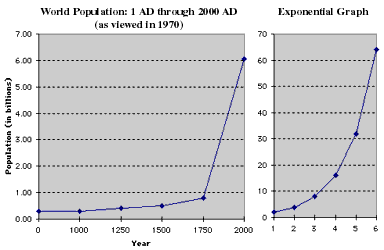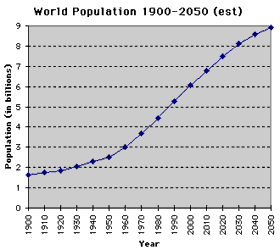| ||||||||||||||||||||||||||||||||||||||||||||
|
The following graphs show how graphing from the same data set can yield wildly different views. In the first graph, I have included data points for every 250 years between 1000 and 2000 on the world population up to 2000. The result is a graph that resembles an exponential graph, shown adjacent to it. This exponential graph is a plot of 2 taken to the power 'n', where 'n' = 1, 2, 3, 4, ... (i.e., 2, 4, 8, 16, 32, 64) In the second graph of the world's population, I have graphed from 1900 out to 2050 using estimates from the UN Web Pages on Population. I have not labeled the projections as tentative, leaving the suggestion that these are real data points. The data are shown in the table following the graphs. World Population Graph A  World Population Graph B  Which is more "real"? Well ... that depends. Graph A is true to world population numbers for the years portrayed. But does it realistically give us any indication of what the future will be like? Arguably not. The last ten years do not follow a projection based on historical numbers. Changes in access to birth control, changes in acceptability of using birth control has dramatically affected fertility rates. World population will NOT continue to increase as it has. Is Graph B more "real"? I guess we'll see. Graph 'B' is misleading, though, in not indicating where hard numbers (the actual world population) end and projections begin. Raw Data for Above Graphs
|
Phil 323 Hot Stuff | Web Project